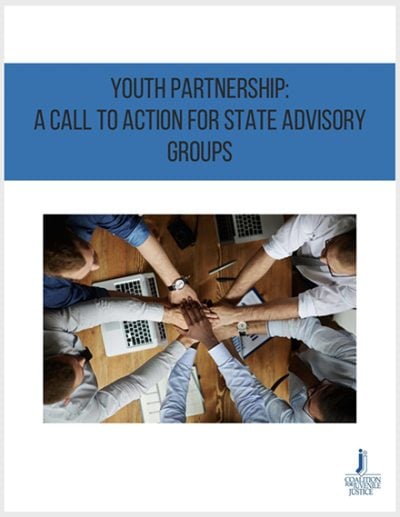Summary
The Coalition for Juvenile Justice (CJJ) released this guide to provide practical support to state advisory agencies (SAGs) in their efforts to achieve meaningful, authentic engagement with young people who have experienced the justice system. The guide includes actions for SAGs no matter their existing level of youth engagement, whether they’ve struggled to meet the basic requirements of youth engagement for years or are looking for new ways to deepen already existing youth partnerships. Each stage of youth engagement — recruitment, onboarding and retention — is divided into 101 (introductory), 201 (intermediate) and 301 (advanced) levels of engagement to help SAGs to honestly self-assess their existing practices and readiness for authentic youth engagement and start taking steps from wherever they are.
Recruitment, Retaining and Paying Youth Partners
Identifying ways to recruit and meaningfully engage people under age 28 with experience in the juvenile justice system has historically been — and remains — a serious challenge for many state advisory groups. However, several states have demonstrated that intentional focus — along with dedicated time and funding resources — results in much better fulfillment of the SAG’s responsibilities and opportunities at the state level. That means going beyond merely “checking the box” of youth membership and instead finding and engaging youth voices from the community.
SAGs should provide new members with onboarding materials written in clear language that cover issues essential to success – such as a handbook of roles and responsibilities, guidelines on language and documents explaining compensation, conflicts of interest and lobbying. Finally, SAGs should establish protocols that make it easy to pay youth members for their work in all SAG-related activities, such as pre-paying for travel expenses and charges where a credit card might be needed, adopting popular payment methods like Venmo and following a publicly accessible guide to stipends and other payment standards.
Power and Relationship in Youth Partnership
Youth members have a right to be heard, to speak and to contribute to the SAG in meaningful ways without being harassed, silenced or manipulated — and SAG meetings should be safe, productive spaces with clear and diverse opportunities for youth members to contribute. SAG leaders should look for ways to support preparation, increase comfort and address inherent power imbalances in youth engagement.
Helping Young People Transition to Professional Roles
Youth SAG members may wish to serve the SAG in a different capacity as they grow into adulthood and gain new professional capacities. SAGs should help youth identify areas of interest and assist youth in the transition into new roles on the SAG whenever possible, offering continuous support as youth members acclimate to their new positions and titles on the SAG. Finally, creating engagement opportunities for young people beyond those who currently serve on the SAG can stir interest in the SAG, help to identify and overcome barriers, implement systemic change, and create equitable solutions to problems that youth face.







